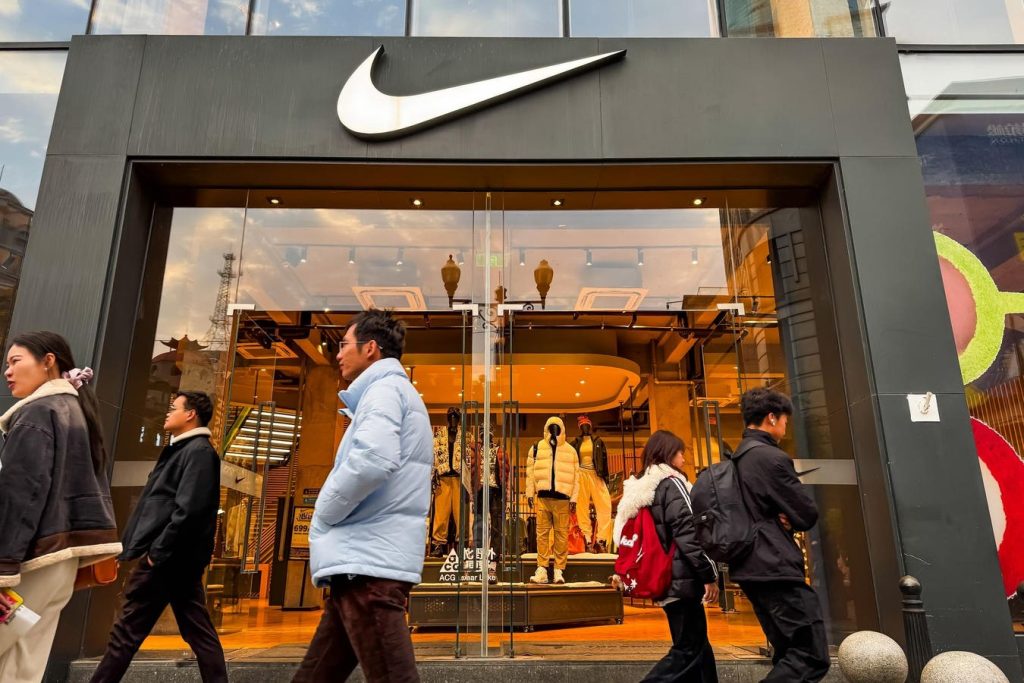Nike, the global sportswear giant, is currently navigating a challenging period marked by declining revenue and earnings. Trading at approximately $77 per share in December 2024, the stock is significantly below its pre-inflation peak of $170 in November 2021. Several factors contribute to this decline, including a slowdown in consumer spending, increased competition, and lingering supply chain disruptions. The company’s fiscal first-quarter results (ending August 2024) revealed a 10% year-over-year revenue drop and a 26% decline in earnings per share. These figures reflect weaknesses across various segments, including digital sales, direct-to-consumer channels, and wholesale partnerships. A leadership change, with the return of Elliott Hill as CEO, signals a renewed focus on addressing these challenges and driving a turnaround.
The near-term outlook for Nike remains cautious. Second-quarter projections suggest a continued revenue decline and shrinking profit margins. Management anticipates fiscal 2025 to be a transitional year, emphasizing the need for innovation and operational efficiencies. Revitalizing digital engagement, which suffered a 20% decline in the first quarter, is a key priority. While the stock has underperformed the broader market in recent years, Nike’s long-term potential remains intact. The company’s dominant market position, strong brand recognition, extensive sponsorship portfolio, and substantial financial resources provide a solid foundation for future growth. Analysts estimate the stock’s fair value to be around $91, suggesting an upside potential of approximately 18% from the current market price.
Nike’s recent performance is contextualized against the backdrop of broader economic trends, particularly the inflationary pressures and market volatility experienced since 2020. The surge in inflation, fueled by supply chain disruptions, increased demand, and geopolitical events, prompted aggressive interest rate hikes by the Federal Reserve. These actions aimed to curb inflation but also contributed to market uncertainty and declines in stock valuations. Nike, like many other companies, felt the impact of these macroeconomic headwinds. The stock’s decline mirrors the broader market downturn, though its performance has lagged behind the S&P 500 in recent years.
Comparing Nike’s current situation to its performance during the 2007-2008 financial crisis provides valuable insights. During that period, Nike’s stock declined by approximately 30% from its pre-crisis peak, mirroring the broader market downturn. However, the company demonstrated resilience, recovering its losses and achieving significant growth in the subsequent years. This historical context suggests that Nike, despite current challenges, has the potential to navigate the current economic uncertainties and rebound in the long term.
A review of Nike’s fundamentals over recent years reveals a mixed picture. While revenue has grown by 15% between fiscal 2021 and 2024, earnings per share have seen a more modest 5% increase. However, the company’s gross margin improved in fiscal 2024, driven by lower freight costs and strategic pricing adjustments. This margin expansion, coupled with the company’s continued investments in brand marketing and innovation, suggests a focus on long-term value creation. Despite the recent slowdown in growth, Nike’s underlying financial strength positions it to weather the current storm and capitalize on future opportunities.
Nike’s turnaround strategy hinges on several key factors. Revitalizing digital engagement is crucial to recapture lost ground in online sales. This involves enhancing the online shopping experience, leveraging data analytics to personalize offerings, and strengthening the company’s direct-to-consumer channels. Operational efficiencies, including streamlining supply chains and optimizing inventory management, will be essential to improve profitability. Continued investment in innovation, particularly in product development and marketing, is crucial to maintain Nike’s competitive edge and appeal to evolving consumer preferences. Finally, effective management of macroeconomic headwinds, such as inflation and potential economic slowdowns, will be essential to navigate the challenging economic environment.
The long-term prospects for Nike remain positive. Despite the current challenges, the company’s strong brand recognition, global reach, and substantial financial resources provide a solid foundation for future growth. As the global economy recovers and consumer spending rebounds, Nike is well-positioned to capitalize on these trends. The company’s ongoing investments in innovation, digital transformation, and operational efficiency will further strengthen its competitive advantage and drive long-term value creation for shareholders. While the near-term outlook remains cautious, the market’s optimism regarding Nike’s turnaround efforts, coupled with the company’s inherent strengths, suggests a potential for significant gains in the future. The company’s historical resilience, demonstrated during past economic downturns, further reinforces this positive outlook.

